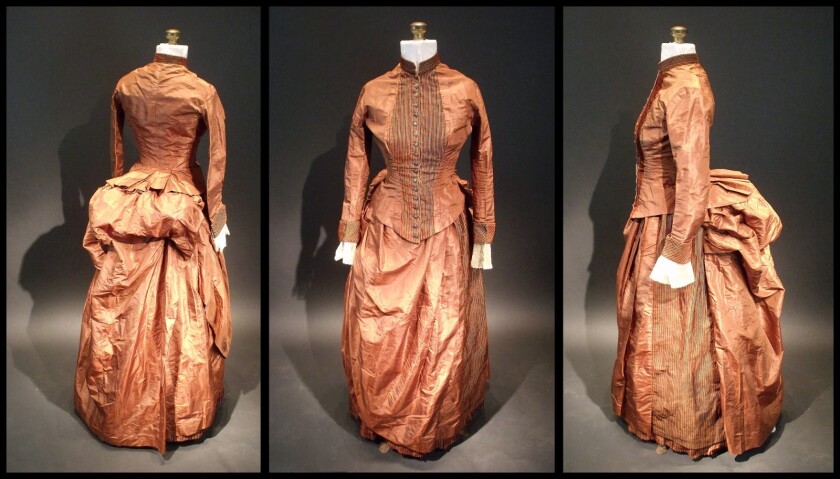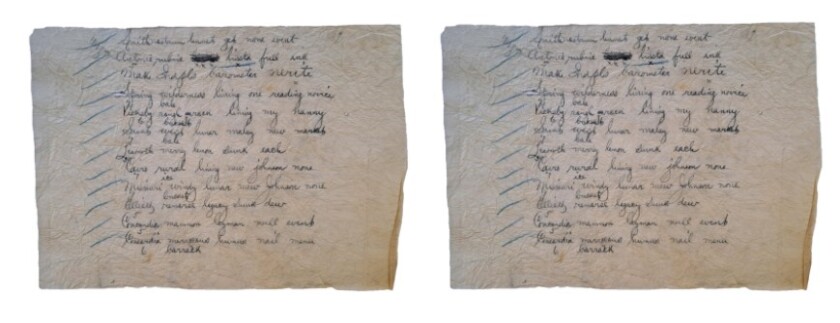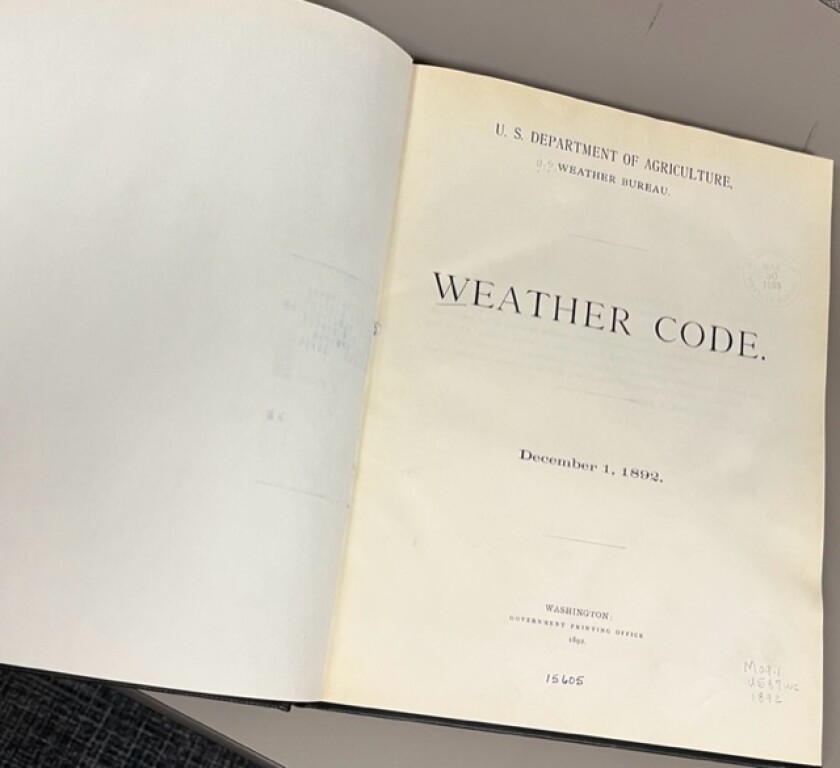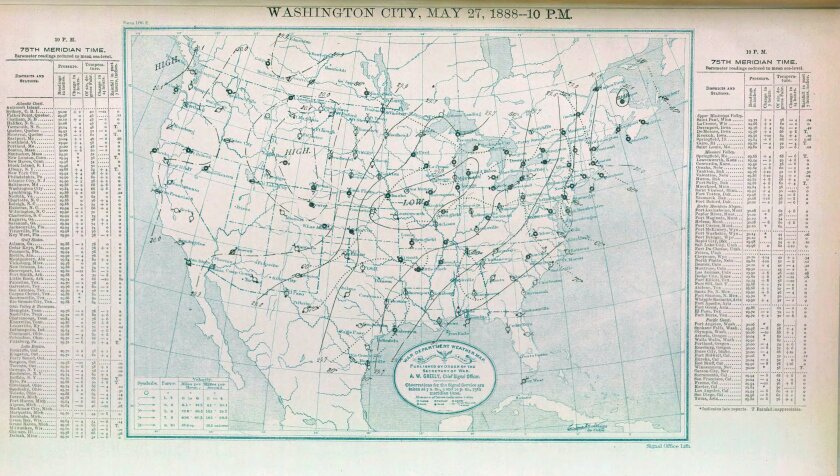BISMARCK — Sara Rivers Cofield loved the dress at first sight.
It was a beautiful brown silk bustle dress with original buttons from the 1880s, on sale at an antique mall in Maine. Rivers Cofield, an archaeologist who also collects antique dresses, bought it for $100, then looked it over.
ADVERTISEMENT
She noticed the name "Bennett" handwritten on a paper tag sewn inside the dress. And there was a pocket, hidden, hard to get to. And it contained something: a clump of balled-up paper.
What she found would spark a nearly decade-long mystery, confound professional and amateur codebreakers alike, and only be solved with a unique historical clue about North Dakota weather hidden in an old book.

Joined by her mom as she examined the dress, River Cofield opened up the clump of paper.
"It consisted of two translucent sheets, both of which exhibited writing," she told readers of her blog " in a "There we were thinking we'd stumbled upon some historic letter, and then we were standing there, each with a freshly unballed sheet of paper, and each suffering from complete bafflement."
The handwritten words on the wrinkled paper didn't make sense. The start of the first sheet read:
Smith nostrum linnets gets none event
101pm Antonio rubric lissdt full ink
5
Make Snapls barometer nerite
The second sheet's beginning didn't make any more sense:
ADVERTISEMENT
1113 PM Bismark Omit leafage buck bank
5
Paul Ramify loamy event false new
What did this all mean, and why had such a nonsensical message been hidden away so carefully?
The hunt for answers
Cofield posted her story and images of the coded papers to her blog, convinced it could be solved by someone. She to the National Security Agency's and posted it on Reddit and Facebook.
"I'm putting it up here in case there's some decoding prodigy out there looking for a project," she wrote.
Her public posts stirred a lot of interest, and speculation, as the mystery went viral online. Were the codewords dress measurements? Perhaps related to illegal gambling? Love notes of some kind?

Some suggested it was a secret Civil War message, but the dress didn't date back that far, Rivers Cofield knew. Others suggested it was a telegraph code, but that was without the exact right code book, Rivers Cofield found.
There were some old telegraph code books on Google Books online, but there were many more out there, most in archives — and Rivers Cofield still had an actual job that required her attention. So the mystery remained unsolved, for the time being. Still, what became known as the "Silk Dress cryptogram" continued to make its way around codebreaking circles.
ADVERTISEMENT
In 2017, German historical encryption expert Klaus Schmeh listed the cryptogram on his blog Cipherbrain as one of the , sparking another flurry of speculation and more research among wannabe codebreakers.
The idea of a telegraphic code still held a lot of promise, many speculated. In the 1800s, networks of wired telegraph stations across the U.S. and around the globe were the only way to quickly send messages from place to place.
Sending these messages was expensive, the cost determined by the length of the message. So codes were devised to shorten the messages, not necessarily to obscure their contents, but to save money. But there were many such codes. Unless you had the right one, a telegraph message would seem like a collection of random words — just like the code in the silk dress.
Still, nobody could break this code from more than a century ago.
Breaking the code
In August 2023, the bombshell news: Someone had broken the code.
His name was Wayne Chan, an analyst with the Centre for Earth Observation Science at the University of Manitoba in Winnipeg, Canada. He published his solution to the code in
Chan had tried to solve the message in 2018 before initially giving up. But Chan was a code-solving hobyist, and soon he was back to solving a seemingly unsolvable cipher.
ADVERTISEMENT
Chan considered the telegraph code idea, and began working his way through nearly 170 telegraphic codebooks. Nothing. Then, he read an old book, The book described a code used by weather field stations across the U.S. and Canada to send reports via telegraph to the Washington, D.C. office of the U.S. Army Signal Service — of the modern day National Weather Service.
Some of the examples in the book seemed similar to those in the coded message from the dress.

Chan got in touch with the Central Library of the National Oceanic and Atmospheric Administration, home to the National Weather Service, who found him a weather code book from 1892.
"I could tell it was clearly the right code — it didn't match exactly but about 90% of it fit," Chan
Then the silver bullet: An 1887 version of the weather telegraph codebook. There it all was. Chan had solved the silk dress cryptogram.
“When I first thought I cracked it, I did feel really excited,” Mr. Chan . “It is probably one of the most complex telegraphic codes that I’ve ever seen."
As NOAA later explained in , such weather messages started with an unencoded station location, followed by code words for various meteorological conditions and sunset observations.
ADVERTISEMENT
That meant "Bismark, omit, leafage, buck, bank" from the code was actually:
- Bismarck: Bismarck, Dakota Territory (North Dakota didn't become a state until Nov. 2, 1889)
- Omit: Air temperature 56 degrees, 30.08 barometric pressure
- Leafage: Dew point 32 degrees, observation time 10 p.m.
- Buck: Clear weather, no precipitation, north wind
- Bank: Wind at 12 mph, clear sunset
Based on archival information from NOAA, that meant the dress message was a weather report from Bismarck on May 27, 1888.

So who owned the dress? That remains an unsolved mystery.
Chan was able to document that a number of women worked as clerical staff at the Army Signal Service office in Washington, D.C. around the date of the weather report. But it's not clear any were named Bennett, nor did his research explain why someone hid away the coded message.
“Presumably, whoever did that is the last person who owned the dress," Rivers Cofield "And presumably, the last person who owned the dress put the code in the pocket.”
River Cofield's silk dress still holds a secret.























